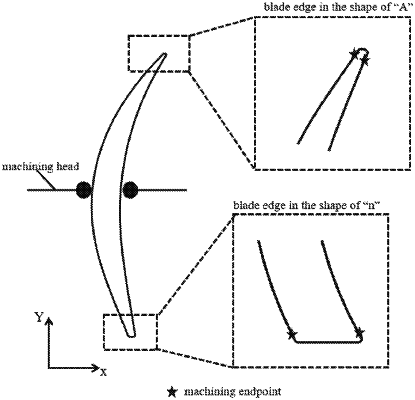| CPC B23P 9/02 (2013.01) | 4 Claims |

|
1. A machining path coordination method for bilateral ultrasonic rolling of blade surfaces, comprising:
Step S1, layering a blade to obtain contour curves with shapes of “A” and “n” of blade edges at different heights of a blade model;
Step S2, determining endpoints of machining paths of the blade;
Step S3, planning blade thickness and rotation angle, which comprising:
Step S31, obtaining main direction angle αm of the contour curves;
Step S32, solving the blade thickness d;
Step S33, obtaining a rotation angle θ required for blade machining when the contour curve is in the shape of “A”,
 wherein αm is main direction angle of the contour curve;
Step S34, obtaining a rotation angle required for blade machining when the contour curve is in the shape of “n”; the step S34 comprising:
Step S341, setting most area of blade body is set as a main direction segment, setting area adjacent front and rear edges as a vertical segment and setting area between the main direction segment and the vertical segment as a transition segment;
Step S342, calculation method of rotation angle for blade machining of the main direction segment is consistent with that of the step S33;
Step S343, the rotation angle for the blade machining of the vertical segment is zero;
Step S344, taking two points P and Q from the transition segment, wherein the point P is an end point of the vertical segment and the point Q is a starting point of the main direction segment, if there are m machining points between points P and Q, the blade will rotate with an interval of angle
 wherein β is the main direction angle at the point Q.
|